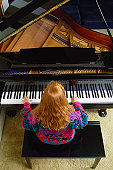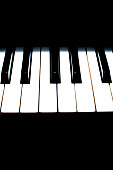
Home > Piano Techniques > Arpeggios & Octaves
|
||||
How to Play Piano Arpeggios & Octaves
The knowledge of playing arpeggios can extend every player's piano performance. The backbone of any melody as well as harmony is the arpeggios. Arpeggios are actually very simple; they are a single chord played note-by-note, but their benefits are countless. The minor arpeggio shows the same characteristics as any minor chord. Its notes are the following: intervals 1, 3, and 5 of the minor scale, or the major scale in 1, flat 3, and 5. Furthermore, with such formulas, playing any arpeggio is possible on the piano or even guitar. Breaking up notes in the C Major Triad -- commonly, the three (3) notes are then played at the same time; however an arpeggio is playing notes in a separate, consecutive manner. You can play the three notes continuously until you reach the C note. By playing an octave with arpeggios, a pianist has more freedom in their playing. Moreover, a pianist can then continually play arpeggios by octaves for two (2), three (3), or more octaves. Go back to the original root note by performing arpeggios in a reversed manner back down into the octave scale. Such performance of arpeggios in the ascending-descending manner can then bring about an intense presentation. Play chord inversions just like arpeggios through performing a C chord up to the following C, and then start on the original arpeggio through a second note. Such arpeggio variations can then be played with each note in the standard root chord.
Next, set your aim on maintaining your entire body relaxed and be sure that your wrists are in a flexible position, same goes with your fingers. Keep your thumb relaxed with an even level with your keyboard, whilst it is good to play using the tip of the thumb instead of the first joint. Such instructions should then be examined with your teacher when necessary. Keeping technique in your mind, you must practice an arpeggio with the use of a metronome. You can perform any rhythm, while one useful method for improving finger tempo and independence includes the following: perform the arpeggio in quarter notes up just one (1) octave. Proceed and perform each tone as eighth notes up to two (2) octaves. Right after going back to the root C, playing the tones as triplets whilst heading up to three (3) octaves is next. Furthermore, perform in sixteenth notes and head up four (4) octaves. In the end, you will find these as helpful establishers of rhythm, while improving your ability to shift between all notes and beat durations. Simply go right through the entire circle of fifths for the major arpeggio; nevertheless, perform the major arpeggio in ever key whilst using all the technique as well as rhythm ideas mentioned above. Perform the minor scales and lastly, if time is extended, remember that playing other arpeggios with the dominant and diminished chords can be helpful in reinforcing your lessons.
http://pianoplayerworld.com/300PagePianoWorkbook.html
| ||||
|
Although every attempt has been made to make information as accurate as possible, we are not responsible for any errors that may appear.
 The arpeggio, a significant musical element, is often taken from major as
well as minor chords and can therefore be smoothly adapt to creative differences on a theme for either a
composition or an improvisation.
The arpeggio, a significant musical element, is often taken from major as
well as minor chords and can therefore be smoothly adapt to creative differences on a theme for either a
composition or an improvisation.
 In practicing piano arpeggios, remember that it is necessary to invest on developing
good
In practicing piano arpeggios, remember that it is necessary to invest on developing
good 



